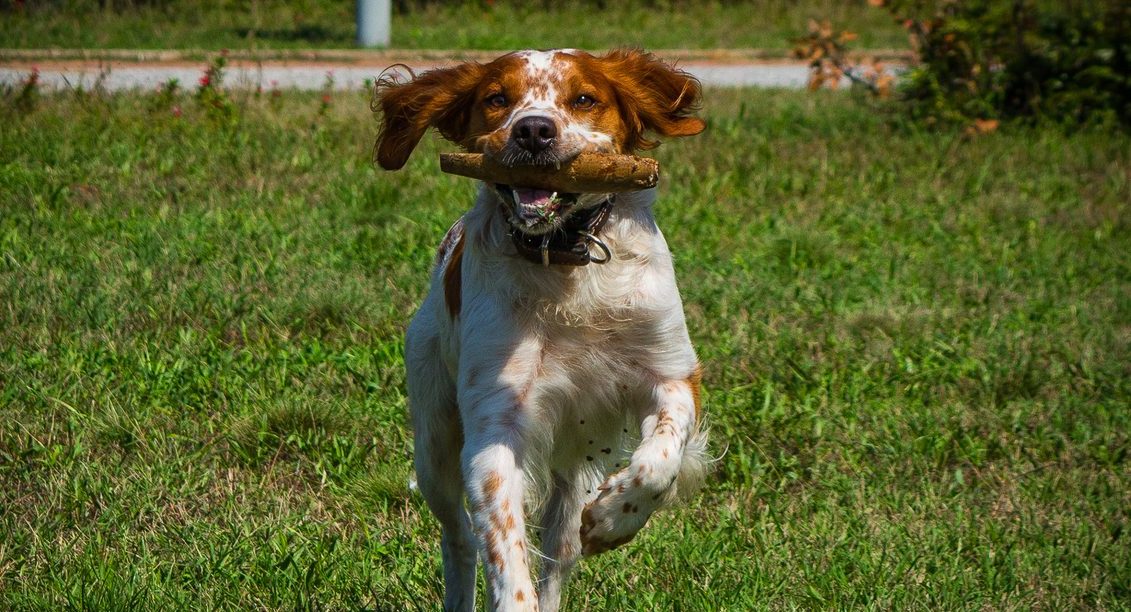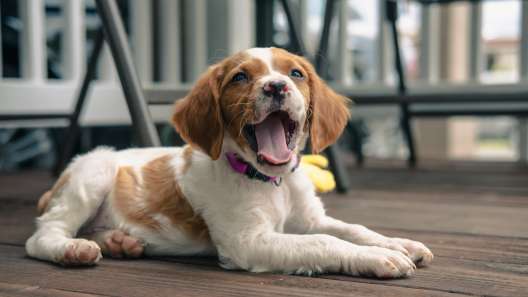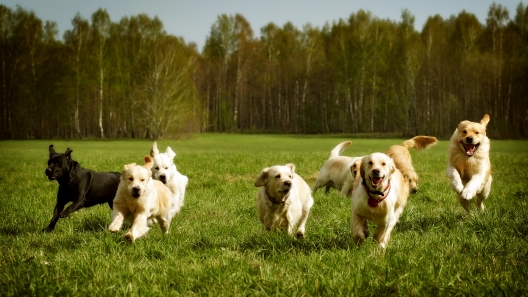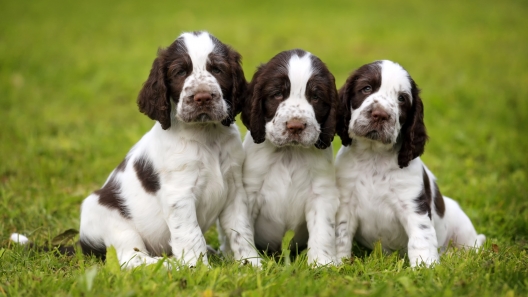-
Activity Level:
high
-
Shedding Level:
moderate
-
Grooming Level:
moderate
-
Trainability:
high
-
Good for Novice Owners:
high
-
Adaptability:
moderate
-
Kid/Pet Friendly:
often
-
Prey Drive:
high
-
Watchdog:
aware
- Average Size: Medium
- Average Lifespan: 12-14 years
- Registered?: aca, akc
Brittany Spaniel Dog Breed Information
Overview
Temperament
Adaptability
Health
Owner Experience
Grooming
Activity Level
Size
Life Span
Did You Know?
The Brittany Spaniel originated in France sometime between the 17th and 19th centuries. More specifically, they were originally bred as a gun dog commonly used for bird hunting and game retrieval in the French province of Brittany. They are often referred to as a type of spaniel, but, thanks to their birding background, their characteristics and style of working are more similar to a setter or a pointer.
The Brittany Spaniel first appeared in art, tapestries, and writings in the 17th century. They appeared in the Paris Dog Show in 1900. This led to France recognizing the breed in 1907 and outlining the first breed standards. The Brittany Spaniel came to the United States in 1931.
The AKC recognized the Brittany Spaniel in 1934 as part of the Sporting Group. Since then, the American and French lines of the breed have diverged. French lines and in France, the dog breed is still called a Brittany Spaniel. American lines tend to be more setter-like than traditional spaniel and this dog breed has been named simply the Brittany in the United States since 1982.
This dog breed generally has a sweet disposition, makes a good companion, and is a great family pet. Brittanys are loyal and attached to their families. They’re known for being bright and cheerful with an upbeat and fun-loving nature. Well-socialized, they get along well with children and other dogs.
They can get along with other pets as long as they have grown up together, but as a hunting dog, they do have a high prey drive. They tend to have a shy nature if they are not thoroughly socialized early on. Even well-socialized Brittanys will have varying levels of openness and friendliness towards strangers.
The Brittany is a moderately adaptable dog breed. They are generally better suited to larger homes with fenced-in yards where they can run. They don’t generally do well in apartments, but can adapt to apartment living if they are given plenty of daily exercise, attention, and mental stimulation.
They do well in just about any climate. As with many dog breeds, they are sensitive to the heat. Although they are hardy, they are a lighter-built dog, so you may need to wrap them in a sweater, doggie coat, or other winter dog products to help keep them warm while out and about in colder temperatures. Brittany Spaniels are also attached to their families and are in tune with their favorite humans, which means they don’t like spending long periods of time alone.
The Brittany is a generally healthy dog breed. As with any dog breed, there are some health conditions to be aware of. In the case of Brittany Spaniels, these potential health issues can include hip dysplasia, epilepsy, eye disease, and canine discoid lupus erythematosus, which is a rare autoimmune disease that affects the skin.
Good breeding practices and the health of the parents make a big difference in the health of Brittany Spaniel puppies. Reputable breeders will screen their dogs to make sure they are not passing preventable issues to puppies.
Make sure you ask the breeder about the health and genetic history of both parents. You can also ask about any health tests or clearances that have been done. The American Brittany Club, Inc. recommends a hip evaluation and an ophthalmologist evaluation.
A Brittany Spaniel is highly intelligent and eager to please, which makes them a highly trainable dog breed. They tend to pick up on things quickly and are sensitive souls. This dog breed responds best to praise-based training. Harsh corrections or tones are unnecessary and counterproductive. Because they pick up on things so easily and are high-energy dogs, they are best suited to dog owners with some experience.
Novice or first-time dog owners can be a good fit for this dog breed, but puppy training classes are usually a good idea to make sure both owner and dog work through an effective training process together. Classes will help first-time dog owners gain the tools and knowledge needed to approach training correctly with a high-energy working dog and ensure the bond established between owner and dog during training sessions is a positive one.
The Brittany Spaniel tends to have a flat or wavy coat. The fur is fairly short with some feathering along the chest, belly, and legs. Shedding is moderate and it tends to get a little heavier as the seasons change, but not by much.
Brushing this dog’s coat a few times a week is sufficient to remove tangles and prevent mats from forming. A soft-bristled brush, a hound glove, and a comb for working out tangles in the featherings are good dog grooming brushes to have on hand. You can also bathe your dog on an as-needed basis.
In addition to coat care, you will also need to trim your Brittany’s nails, regularly check their ears, and brush their teeth. Because of how active the Brittany Spaniel is, their nails may wear down naturally. Still, you’ll want to check their nails and trim them once or twice monthly as needed to keep them from getting too long.
Floppy ears, like the Brittany has, are more likely to trap dirt, debris, and moisture, which can lead to ear infections. By regularly checking your dog’s ears and carefully cleaning them as needed, you can help keep your dog comfortable and help prevent ear infections.
Proper dental care for dogs is so important, but it is often overlooked. This is why dental diseases, like gum disease and tooth decay, are one of the most common health issues in dogs. With good dental care, you can help prevent the tartar buildup that causes these dental diseases and protect your dog.
Brushing their teeth or using an enzyme toothpaste every day is a great start, in addition to cleanings at the vet when needed. You can also supplement your dental care efforts with dental hygiene chews, dental treats, and even a specially-formulated dental care diet.
Generally, it’s a good idea to get your Brittany Spaniel used to having their mouth, ears, and paws handled as a puppy and to reward them throughout grooming sessions. This will help make grooming a much easier and more enjoyable process for both of you. Plus, grooming can be a way to build a bond with your dog and can even become a positive bonding experience that your dog looks forward to!
This is a high-energy dog breed. In addition to daily walks, the Brittany Spaniel also needs at least one hour of more vigorous exercise every day, if not more. Many Brittanys require more than that to stay happy and healthy.
As the cliche goes, a tired dog is a happy dog, and often a well-behaved one too. Without proper exercise and mental stimulation, the Brittany can potentially become overreactive, hypersensitive, destructive, or other signs your dog isn’t getting enough exercise.
The Brittany Spaniel is a hardy and active dog breed. This, and the fact that they love spending time with you, make outdoor activities a great fit for making sure this dog gets enough exercise. You can take your dog hiking with you or on a swim if they enjoy the water. Brittany Spaniels are also one of the dog breeds that make good running partners.
Their light-boned structure, energetic nature, endurance, and agility make them a good fit for both short and long distances. They’re also a good candidate for many popular dog sports like agility, tracking, dock diving, flyball, obedience, and more. Just make sure to keep things low-impact while puppies are still growing to avoid damaging developing bones and joints.
A fully-grown Brittany Spaniel usually stands around 18-20 inches tall at the shoulder and weighs 30-40 pounds.
Brittany Spaniels generally live for 12-14 years on average.
One of the facts about Brittany Spaniels is that more Dual Champions have been a Brittany than any other AKC-recognized breed in the Sporting Group.









